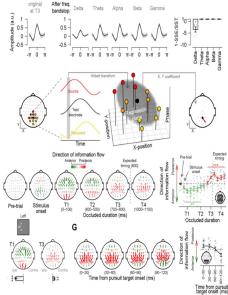Publication
International
| 논문명 |
Frontal-to-visual information flow explains predictive motion tracking |
|---|---|
| 저자 |
Sangkyu Son, Joonsik Moon, Yee-Joon Kim, Min-Suk Kang, Joonyeol Lee |
| 저널 |
Neuroimage 269, 119914-(2023) |
| Abstract |
www.sciencedirect.com/science/article/pii/S1053811923000629?via%3Dihub |
|
Predictive tracking demonstrates our ability to maintain a line of vision on moving objects even when they temporarily disappear. Models of smooth pursuit eye movements posit that our brain achieves this ability by directly streamlining motor programming from continuously updated sensory motion information. To test this hypothesis, we obtained sensory motion representation from multivariate electroencephalogram activity while human participants covertly tracked a temporarily occluded moving stimulus with their eyes remaining stationary at the fixation point. The sensory motion representation of the occluded target evolves to its maximum strength at the expected timing of reappearance, suggesting a timely modulation of the internal model of the visual target. We further characterize the spatiotemporal dynamics of the task-relevant motion information by computing the phase gradients of slow oscillations. We discovered a predominant posterior-to-anterior phase gradient immediately after stimulus occlusion; however, at the expected timing of reappearance, the axis reverses the gradient, becoming anterior-to-posterior. The behavioral bias of smooth pursuit eye movements, which is a signature of the predictive process of the pursuit, was correlated with the posterior division of the gradient. These results suggest that the sensory motion area modulated by the prediction signal is involved in updating motor programming. |
|


